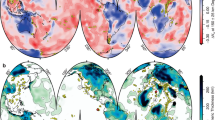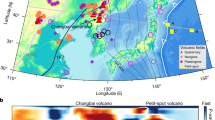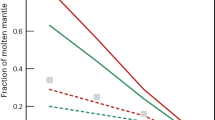Abstract
It has long been recognized that the properties of the Cook–Austral chain (Fig. 1) of volcanoes in the South Pacific are difficult to reconcile with the theory that volcanic activity in plate interiors is produced by the drift of tectonic plates over narrow, stationary plumes1 of hot mantle material upwelling from depth. Radiometric dates2,3 from many island samples are younger or older than would be predicted if a single plume currently located at volcanically active Macdonald seamount4 was responsible for all of the volcanoes. Indeed, only the southernmost part of the Austral volcanic line has hitherto appeared to be consistent with plume activity, and then only within the past 6 million years (Myr)5,6. Here we report radiometric dates that demonstrate that these southern Austral volcanoes are actually composed of three distinct volcanic chains with a range of ages spanning 34 Myr and with inconsistent age progressions. Gravity anomalies and seafloor fabric suggest that the volume and location of volcanism in this region is controlled by stress in the lithosphere rather than the locus of narrow plumes rising from the deep Earth.

The solid red line is the locus of present-day sea-floor spreading in the Pacific. The broken red line is the 30-Myr isochron25. The box shows the location of the region surveyed in the southern Austral islands. Open circles (Ngatemato), triangles (Taukina) and stars (Macdonald) indicate the location of dredge sites for dated volcanic rocks; filled counterparts show the reconstructed positions of the dated volcanic rocks when they erupted using Pacific-hotspot finite rotation poles7. The thick black line gives the location of the profile shown in Fig. 3.
This is a preview of subscription content, access via your institution
Access options
Subscribe to this journal
Receive 51 print issues and online access
$199.00 per year
only $3.90 per issue
Buy this article
- Purchase on Springer Link
- Instant access to full article PDF
Prices may be subject to local taxes which are calculated during checkout



Similar content being viewed by others
References
Morgan, W. J. Convection plumes in the lower mantle. Nature 230, 42–43 (1971).
Dalrymple, G. B., Jarrad, R. D. & Clague, D. A. K-Ar ages of some volcanic rocks from the Cook and Austral Islands. Geol. Soc. Am. Bull. 86, 1463–1467 (1975).
Turner, D. L. & Jarrard, R. D. K-Ar dating of the Cook-Austral Island chain: A test of the hot spot hypothesis. J. Volcanol. Geotherm. Res. 12, 187–220 (1982).
Johnson, R. H. Active submarine volcanism in the Austral Islands. Science 167, 977–979 (1970).
Krummenacher, D. & Noetzlin, J. Ages isotopiques K/Ar de roches prélevées dans les possessions françaises du Pacifique. Soc. Géol. Fr. Bull. 8, 173–175 (1966).
Duncan, R. A. & MacDougall, I. Linear volcanism in French Polynesia. J. Volcanol. Geotherm. Res. 1, 197–227 (1976).
Duncan, R. A. & Clague, D. A. in The Pacific Oceans (eds Nairn, A. E. M., Stehli, F. G. & Uyeda, S.) (Plenum, New York, (1985)).
Mammerickx, J. The Foundation Seamounts: tectonic setting of a newly discovered seamount chain in the South Pacific. Earth Planet. Sci. Lett. 113, 293–306 (1992).
Watts, A. B., Bodine, J. H. & Ribe, N. R. Observations of flexure and the geological evolution of the Pacific basin. Nature 283, 532–537 (1980).
McNutt, M. K. & Menard, H. W. Lithospheric flexure and uplifted atolls. J. Geophys. Res. 83, 1206–1212 (1978).
Calmant, S. & Cazenave, A. Anomalous elastic thickness of the oceanic lithosphere in the south-central Pacific. Nature 328, 236–238 (1987).
Goodwillie, A. M. & Watts, A. B. An altimetric and bathymetric study of elastic thickness of the central Pacific Ocean. Earth Planet. Sci. Lett. 118, 311–326 (1993).
Sleep, N. H. Lateral flow and ponding of starting plume material. J. Geophys. Res. 102, 10001–10012 (1997).
Cande, S. C. & Haxby, W. F. Eocene propagating rifts in the southwest Pacific and their conjugate features on the Nazca plate. J. Geophys. Res. 96, 19609–19622 (1991).
Johnson, R. H. in Research Reports (eds Oehser, P. H., Lea, J. S. & Powars, N. L.) 389–405 (National Geographic Society, Washington DC, (1971)).
Hart, S. R. Alarge-scale isotope anomaly in the southern hemisphere mantle. Nature 309, 753–757 (1984).
Barsczus, H. G. Les isles Australes (Polynesie Francaise) et la theorie des points chauds (Office de la Recherche Scientifique et Technique Outre-Mer, (1980)).
Menard, H. W. & McNutt, M. K. Evidence for and consequences of thermal rejuvenation of the lithosphere. J. Geophys. Res. 87, 8570–8580 (1982).
Su, W.-J. The Three-Dimensional Shear-Wave Velocity Structure of the Earth's Mantle (Harvard Univ. Press, (1992)).
McNutt, M. K. & Judge, A. V. The superswell and mantle dynamics beneath the South Pacific. Science 248, 969–975 (1990).
Hedge, C. E. Strontium isotopes in basalts from the Pacific Ocean basin. Earth Planet. Sci. Lett. 38, 88–94 (1978).
Richter, F. M. & Ribe, N. M. On the importance of advection in determining the local isotopic composition of the mantle. Earth Planet. Sci. Lett. 43, 212–222 (1979).
Hofmann, A. W. Mantle geochemistry: the message from oceanic volcanism. Nature 385, 219–229 (1997).
Smith, W. H. F. & Sandwell, D. T. New global seafloor topography from satellite altimetry. Eos 77, F315 (1996).
Müller, R. D., Roest, W. R., Royer, J.-Y., Gahagan, L. M. & Sclater, J. G. Digital isochrons of the world's ocean floor. J. Geophys. Res. 102, 3211–3214 (1997).
Acknowledgements
We thank W. Smith for providing the predicted bathymetry data, and J.-G. Schilling, M. Maia and N. Sleep for reviews. This work was supported by the US National Science Foundation.
Author information
Authors and Affiliations
Corresponding author
Rights and permissions
About this article
Cite this article
McNutt, M., Caress, D., Reynolds, J. et al. Failure of plume theory to explain midplate volcanism in the southern Austral islands. Nature 389, 479–482 (1997). https://doi.org/10.1038/39013
Received:
Accepted:
Issue Date:
DOI: https://doi.org/10.1038/39013
This article is cited by
-
Constraints on HIMU and EM by Sr and Nd isotopes re-examined
Earth, Planets and Space (2014)
-
Hotspot trails in the South Atlantic controlled by plume and plate tectonic processes
Nature Geoscience (2012)
Comments
By submitting a comment you agree to abide by our Terms and Community Guidelines. If you find something abusive or that does not comply with our terms or guidelines please flag it as inappropriate.



